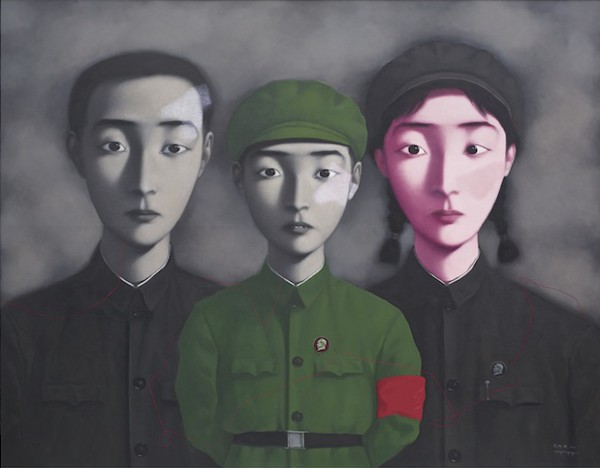Analysis
Are Chinese Collectors Turning China’s New Art Into a Global Asset?
All eyes are on Sotheby's April 5 sale in Hong Kong.

All eyes are on Sotheby's April 5 sale in Hong Kong.

Jing Daily

![]()
Despite a record-setting year in 2013, Chinese contemporary art prices have long lagged behind those of pieces by top Western artists. As the spring art auction season arrives, this discrepancy is still obvious, but a rising tide of Chinese collectors pushing up Asian art prices means that the difference may not be so dramatic for long.
The global art market rebounded to almost pre-financial crisis levels in 2013, with wealthy buyers setting massive new records for both Chinese and Western contemporary pieces. In October, Zeng Fanzhi’s The Last Supper set the world record for the most expensive piece of Chinese contemporary art ever sold at auction when it went for $23.3 million at Sotheby’s.
That may seem like a staggeringly high price, until one compares it to that of Francis Bacon’s Three Studies of Lucian Freud. The piece set the world auction record for an art sale when it sold last fall, dwarfing the Chinese contemporary record at $142.4 million. Right now, even the most expensive works of Chinese contemporary art haven’t reached the likes of Andy Warhol, whose new record at auction of $105 million was also set last year, Jeff Koons, whose sculpture Balloon Dog (Orange) sold for $58.4 million in the fall of 2013, or even Christopher Wool, whose Apocalypse Now went for $26.4 million at Christie’s in November of last year.
The price difference between the two contemporary categories is apparent in this season’s auction catalogues as well, but the current lower numbers for Chinese art point to a major investment opportunity for blue-chip collectors.
Sotheby’s modern and contemporary art evening sale in Hong Kong on April 5 leads off the spring auction season for major Chinese contemporary sales, and estimated prices for the most expensive pieces are still far below those of their Western counterparts. Estimates for top blue-chip Chinese artists fall in a range around $1 million to $5 million—with most expected to go for no more than $3 million and some with estimates as high as $10 million. Many of China’s top pieces still fall on the low end compared to top Western contemporary prices, which can often sell for between $5 million and $50 million.
For Sotheby’s April 5 sale, works by top mainland painters Zhang Xiaogang, Zeng Fanzhi, Liu Ye, and Yue Minjun are among the highlights of the list, in addition to Chinese-French painters Zao Wou-ki and Sanyu. Zhang Xiaogang’s Bloodline: Big Family No. 3 is the main Chinese contemporary highlight of the auction, with an estimated price of about $8.4 million to $10.3 million. Described as one of Zhang’s most important works, Bloodline: Big Family No. 3 is an especially rare early piece in the artist’s oeuvre.
Other top Chinese contemporary lots in the sale are estimated in the single-digit millions. Two paintings by Zeng, including a diptych and a piece from his Mask Series, are estimated to sell in a range between $1.4 million and $3 million. Liu Ye’s Sinking Ship is expected to go for between $1.5 million and $2.5 million, while Yue Minjun’s Garbage Hill has been assessed to fetch between $1.2 million and $2 million.
These prices may be lower than those of the Western blue-chip pieces for now, but an increase in the number of new Chinese collectors is likely to push values higher in the future. China’s rising contingent of newly wealthy individuals is becoming increasingly educated about art and taking a pragmatic approach when it comes to auction purchases, viewing Chinese art as an asset class.
This trend has already taken root. Because China’s wealthy value hard assets as a major source of investment, these new Chinese collectors have been flooding into the auction market and pushing up prices on everything from Chinese antiques to jadeite jewelry, as well as classical and contemporary art. That’s why global auction giants Christie’s and Sotheby’s both expanded their presence into mainland China last year, and Christie’s saw 44 percent growth in Asia sales for 2013. China accounts for almost one fourth of all global art sales, making it the world’s second-largest art market.
As more Chinese collectors move into the Chinese contemporary market, the scarcity that ensues is also likely to cause works’ values to appreciate. The addition of even a few hundred collectors to the marketplace would mean that demand would outpace supply at a much higher rate. All tiers of the market are likely to see the effects 0f this, with works in the highest estimates setting new world records, and those in the low millions climbing into the double-digit range, thus creating numbers more parallel with those for Western works.
Chinese contemporary art’s cultural clout has also been on the rise, making breakthroughs in major global art shows in the past year. The Metropolitan Museum of Art’s “Ink Art” exhibition is museum’s first-ever Chinese contemporary show in its history, while the New York Armory Show’s Focus: China section highlighted the category as well. Zeng Fanzhi in particular had a banner year: In addition to the world-record sale, his work was featured in a major retrospective at the Musée d’Art Moderne in Paris.
For collectors looking for blue-chip investment opportunities, the promise of rising Chinese contemporary prices is founded on far more than just market speculation. The gap between Western and Chinese prices is likely to narrow in the coming years, making sooner rather than later a solid bet for buyers.
This story originally appeared on Jing Daily, an artnet News content partner.